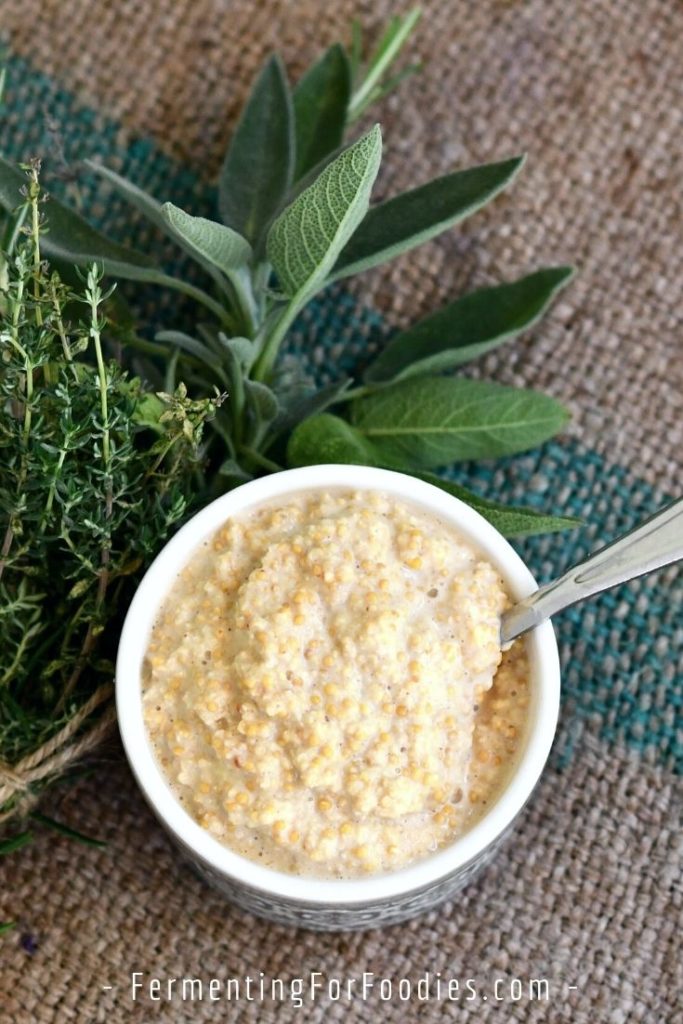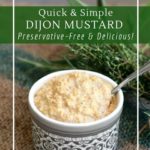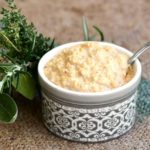
This classic Dijon mustard recipe is very easy. It really only takes 5 minutes to make after soaking the mustard seeds. The result is a rich and flavorful mustard that will last for months in the fridge.
Why make mustard?
I have been making homemade mustard for a long time. Here’s why:
- Nearly every store-bought jar of Dijon mustard contains added sulfites. It’s what keeps the mustard looking bright for the duration of its shelf-life. Since there are sulfite allergies in my household, this Dijon mustard recipe is our best option.
- Homemade mustard is SO EASY. It takes about 5 minutes and I can make all sorts of different flavors, like this yellow hot dog mustard.
- Homemade mustard lasts just as long in the fridge as store-bought mustard. So I make a few pints every 6-8 months.
- Dijon mustard is perfect for adding a sharp and pungent flavor to everything from salad dressing to cheese sauce. So having a large jar of Dijon mustard in my fridge is a culinary necessity.
- It’s zero-waste! And we’re really trying to do our part to reduce the amount of packaged goods that we buy.
Different Soaking Liquid Options
The traditional Dijon mustard recipe involved mixing mustard seeds with verjuice (basically unfermented wine made from sour fruits). Modern recipes usually involve wine or cider. And store-bought Dijon usually is made with white wine.
Honestly, I’ve been making Dijon for years with whatever I happen to have available. It always works out, and it’s always delicious. Since the goal is to replace the traditional verjuice, with a sour fruity liquid, there are two main options.
1. Wine or hard cider
This Dijon mustard recipe is ideal for anyone who makes homemade wine or cider. Just use whatever you happen to have available.
I’ve made homemade Dijon mustard with plum wine, pear cider, and peach wine. It’s perfect for that bit of liquid that is left over when you’ve racked your wine to a clean jug. Just pass the liquid through two layers of butter muslin to remove the spent yeast and other solids.
If you don’t brew your own wine, then use white wine instead.
2. Apple Cider Vinegar or kombucha
Apple cider vinegar and sour kombucha tea are also perfect for mustard. The trick is to balance the acidity. This is why the Dijon mustard recipe suggests using a mixture of vinegar and water.
Feel free to use other fruit vinegar instead. Just don’t use white vinegar or balsamic vinegar which would both dramatically change the flavor.

Dijon Mustard
Homemade Dijon mustard is so quick and easy. Unlike store-bought mustard, it is preservative-free. It’s perfect for salad dressing, sauces, and sandwiches.
- Prep Time: 15 minutes
- Total Time: 15 minutes
- Yield: 1 cup 1x
- Category: Condiment
- Method: Fermented
- Cuisine: French
Ingredients
- 1/2 cup mustard seeds (see notes)
- 3/4 cup of soaking liquid (wine or ACV and water, see notes)
- 1/2 tsp salt (non-iodized)
- 2 Tbsp filtered water
Instructions
- Mix the mustard seeds with the soaking liquid in a glass container. I recommend a 2 cup mason jar.
- Leave the mustard seeds on the count to soak for 2 days.
- Add the salt, then using a blender or an immersion blender, grind the seeds and any remaining soaking liquid to the desired consistency. It is fine to have a smooth Dijon mustard or to leave some of the mustard seeds whole.
- If needed, add a few tablespoons of extra water as you grind. The amount of liquid needed will depend on the type of mustard seeds and how smooth you want the mustard to be.
- Store in a glass jar with an air-tight lid in the fridge. Allow the mustard to ripen for at least 2 weeks before using. Fresh Dijon is very hot, but the flavor will mellow over time.
Notes
- A mixture of yellow
and black mustard seeds
is traditional. But using just yellow seeds is fine. Black mustard seeds tend to be hotter. They also require a bit of extra liquid, so expect to add more water when you blend.
- For a classic Dijon mustard 3/4 cup of dry white wine for the soaking liquid. For alcohol-free, probiotic mustard, use 1/4 cup apple cider vinegar and 1/2 cup of water. See the section above for more options, including using kombucha or homemade fruit wine.




Great mustard. Went well with the first hotdogs of the season.
Thanks! It is one of my favourite recipes.
Can i ferment dijon mustard? Jus curious 😉
If you use cider vinegar with a mother, then it’s probiotic. And soaking the mustard seeds certainly breaks them down… but it is not fermented in the traditional sense.
Is there a way to make it without the wine as I can’t use it? Like just add water and let it ferment outside the refrigerator. Thanks. wine.
The wine is what provides that Dijon flavour… You could make it with water, but you might enjoy a different flavour of mustard instead? https://www.fermentingforfoodies.com/fermented-yellow-mustard/
I used 1/4 c kombucha and 1/4 c sauerkraut juice instead of white wine. It turned out well! I am making the next batch with just kombucha.
Sounds yummy! A sour kombucha could also replace the cider vinegar.
hi,
is it possible to use Rejuvelac as fermenting medium and if yes, how would you combine it?
I haven’t made Dijon with rejuvelac. I don’t think it would provide the acidity typical of mustard flavor. However, you could use rejuvelac for the fermenting liquid, then maybe add 2 Tbsp ACV instead of water for finishing at the end. If you try it, let me know how it goes!
when soaking the seeds, salt and vinegar, what do you cover the jar with? sealed ? , airlock? thanks, anxious to try
No need for an airlock. Just cover loosely with the lid or a towel. The vinegar is enough to keep out any contaminates. Enjoy!
This definitely beats the store-bought stuff! I love dijon mustard, but don’t have it too often because of the added Sodium Metabisulphate. Great recipe, thanks for sharing this, I’ll have to give it a try if I can get some mustard seeds! 🙂
Thanks! We don’t do well with sulfites, so I’ve been using this Dijon recipe for years. You can find mustard seeds online, or try an Indian or South Asian grocery store. They’ll sell large bags of spices.
Love your website 🙂 Question: I don’t have a grinder, only a stone grinder. Why do the mustard seeds have to be grindered after the 2 days soaking? Would it be possible to grind them at the beginning of the process?
Thanks! It is easiest to make smooth mustard by grinding after soaking. However, you could use your stone grinder to crack the mustard seeds ahead of time. Or if that’s too much work, you could leave it as a grainy mustard. If you’re making grainy Dijon, then I recommend draining the mustard after soaking to reduce the amount of liquid.
I fermented the seeds for 6days in water/salt brine and added a culture capsule. The smell was horrendous. Why? I blended it with apple viniger after and waiting for results…
Hi Ivanto, I haven’t tried fermenting with a culture capsule, nor for that long. Does the flavor smell fermented or perhaps a strong sulfur smell? (That could be the capsule). Though mustard seed can smell strong, it shouldn’t smell horrendous. I recommend sticking it in the fridge for 2 weeks, then try smelling it. Hopefully, it smells like mustard. Good luck!
Hi. Tnx for the feedback. Well, i do think its a ferment smell… sulfur for sure but also something else. I read few articles and it says its the normal ferment smell. I do thing it has mellowed down.
Now to your instructions with a new batch.
Thx again!
Sulfur is fine… but it shouldn’t smell rotten. Maybe try fermenting for a shorter period of time. Good luck!
Oops! Yes. Will fix that typo right now. 🙂
I wanted to cut the recipe in half because I don’t use mustard a lot. Followed the instructions but the next morning I discovered all the liquid was gone from the jar during the initial 2 day soak. So I added extra liquid which would add up to the original recipe, but I only used 4 TBS of mustard seeds. Hoping for the best because your recipe sounds really good.
Wow! That is interesting. However… it might be your mustard seeds. I’ve found that different types (yellow, brown, black) absorb different amounts of liquid. Really, you only need enough liquid to get the right consistency for you. It won’t affect the flavour that much. If you plan on grinding the mustard seeds, then you will definitely need to add more liquid. Hope you enjoy it!
How long can you keep this in the refrigerator?
I usually make a double batch and use it up within 6 months. We use a lot of Dijon. 🙂
Did I do something wrong? I doubled the recipe (96g mustard seeds and 356 ml of soaking liquid), let it sit on the counter for two days then ground it all up. Turned into a mustard smoothie – way too much liquid. Was I supposed to drain the soaking mixture out and reserve several tablespoons? What did I do wrong?
Hi Denise, You don’t need to drain the soaking mixture or anything like that. I think the issue is my recipe card… (something I pay for, so I will be sending them an email). I wrote the recipe by volume, and I’m surprised it went to by weight for the metric conversion. Regardless, I think 96 g is too little mustard seed. It should probably be closer to 200 g (100 g per 1/2 cup). Not your fault, and I will send the app developers an email today.
Sorry, it didn’t work out for you! Cheers, Emillie
The app developer got back to me very quickly! Apparently, the issue is that the conversion was for mustard powder because they don’t know the weight of mustard seed. They’re looking into it and hopefully, it will be resolved soon! Thanks for sharing and resolving this issue for everyone using this (very popular) recipe card. Cheers! Emillie
I figured it might have been a glitch in the conversion app. As I had already bought 200g of mustard seeds, I simply added what I had left to the mustard “smoothie,” let it soak a bit, then ground it all down with an immersion blender. Voilà – perfect consistency! Still a little bitter for my taste, but the edge should smooth out a bit with time. Thanks for your quick response.
It does mellow out after a few weeks. Cheers!
Most mustard recipes I’ve made contain vinegar. While you address using vinegar you do not include vinegar in the recipe. Can you explain why. I prefer using white wine for the soaking liquid. If I use some vinegar is that included with the soaking liquid (if so, how much)? Or should vinegar be used as the extra liquid added when grinding the soaked seeds?
I love the simplicity of your recipe, but my gut tells me there should be vinegar in the ingredient list. Can you clarify?
Thank You 🙂
Hi Louis,
Dijon is traditionally made with just wine. Ideally, slightly old white wine that has started to go vinegary. 🙂 So no added vinegar is required. I’ve included an ACV with water alternative for people who don’t drink wine. I’ve tested both ways of making Dijon, though typically I use wine. In my case, it’s most often leftover fruit wine, as I make quite a bit of fruit wine.
If you would like to include some vinegar in the soaking liquid, I guess you could add 2 Tbsp, removing 2 Tbsp of wine. However, I haven’t tried it, so I don’t know what the flavor will be like.
Cheers, Emillie
Thank you Emillie for your quick reply. I’m taking your advice and not using vinegar. have a mix of yellow and brown mustard seed soaking in Sauvignon Blanc now.
Thank you so much.
Yum! Expect it to be quite spicy for at least 2 weeks. The mustard seeds should eventually mellow. But brown mustard will probably remain quite spicy. Enjoy!
I followed this recipe to a T, and it was honestly awful. Putrid. This is not for the sake of writing a bad review, I did everything as instructed. Bought my mustard seeds from Penzy’s Spices and waited the full 2 weeks as instructed. I used a very good burgundy white wine. Everything was sterile as well. I’ll have to try another recipe.
I’m sorry this didn’t work out for you. I make Dijon all the time (haven’t bought it in 10+ years) and have never had a failure. It sounds like you did everything right… soaking for 2 days on the counter before placing it in the fridge for 2 weeks to age. I have no suggestions. Cheers, Emillie